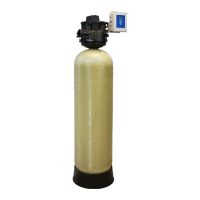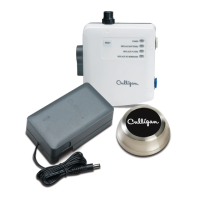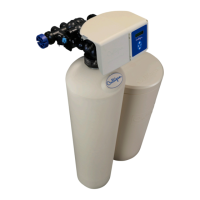96 Culligan® CSM Series Softeners
96 Cat. No. 01016370
Appendix C Aqua-Sensor Guidelines
Aqua-Sensor Application Guidelines
Parameter Value
Hardness (gpg as CaCO
3
) 7 - 99 (See Notes 1 and 2)
Solube iron (ppm as Fe) < 2 (See Note 3)
Manganese (ppm as Mn) < 0.5 (See Note 4)
Hardness vs Salt Dosage See Table 17 and Note 2
TDS to Hardness Index TDS hardness (as CaCO
3
) < 10 (i.e. hardness must be at least
10% of TDS; see Note 5)
Temperature, °F Any within equipment’s operating range
Alum and phosphate Anecdotal evidence indicates potential foulant; effect has not
been confirmed experimentally
Commercial cell: distance betwen sensing and reference cell pairs 6 inches (See Note 2)
Table 17. Hardness vs. Salt Dosage
Hardness (as CaCO
3
) Recommended Salt Dosage (lbs/ft
3
)
7 - 10 5 - 6
10 - 15 6 - 8
15 - 25 8 - 9
25 - 50 9 - 11
50 - 75 11 - 12
75 - 99 12 - 16
Table 18. Resin Bed Depths and Estimated Capacity per Inch at Various Salt Dosages
Model Tank
Size
Resin
Qty.
Depth
of Resin
(in.)
Grains Capacity
per inch (10 lbs/ft
3
salt dosage)
Grains Capacity
per inch (6 lbs/ft
3
salt dosage)
Reserve Capacity
@ 10 lb Salt
Dosage (grains)
6
Reserve Capacity
@ 6 lb Salt
Dosage (grains)
6
150 20x54 5 27.5 4545 3636 27270 21816
210 24x54 7 26.7 6554 5243 39324 31458
300 30x60 10 24.4 10227 8181 61359 49087
450 30x60 15 36.7 10227 8181 61359 49087
600 36x60 20 34.0 14726 11781 88357 70686
750 42x60 25 31.2 20044 16035 120264 96211
900 42x60 30 37.4 20044 16035 120264 96211
Notes:
1. Although the Aqua-Sensor device has been used successfully on water with hardness as low as 3 gpg, there is
an increased risk of missed signal (no regeneration) when the hardness is less than 6 gpg.
2. For each tank diameter, there is a specific volume of resin in the space between the cell pairs. The capacity of
that resin is influenced by hardness and salt dosage. Any combination of flow rate and hardness that causes
the hardness front to pass through that volume of resin in less than 6 minutes will result in the sensor failing to
detect the need to regenerate. In general, the volume of resin between the cell pairs on commercial units will
permit a proper signal at or below the continuous flow rating when raw water hardness is less than 50 gpg. At
higher hardness levels, it may be necessary to reduce the flow rate to assure adequate sensor signal duration.
3. If precipitated or bound iron is present it must be removed before the softener.
4. Manganese can deposit on the sensor electrodes, particularly on the upper pair, causing missed signals (no
regeneration). Periodic cleaning may be needed to maintain satisfactory performance.
5. Adequate signal strength has been demonstrated at ratios as high 14 but signal strength diminishes with
decreasing TDS to hardness index.
6. Amount shown is based on the distance between the referencing cell pairs. Reserve capacity at salt dosages
less than 15 lbs per cubic foot are shown for reference purposes only and may not provide adequate represen-
tation of actual capacity per inch of bed depth for operational purposes.

